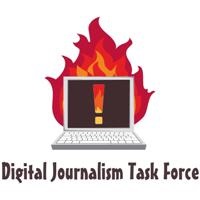By Benét J. Wilson, DJTF co-chair, Online Managing Editor-Business Aviation, Aviation Week Group
 I am a journalist who has never been interested in following the entrepreneur path. I just don’t have the desire or the mindset to do it. But I know plenty of journalists who are thinking of or actually following their entrepreneurial dreams as a way to stay in the game as newsrooms continue with job cuts. And I feel the Digital Journalism Task Force has a responsibility to help those follow those dreams.
I am a journalist who has never been interested in following the entrepreneur path. I just don’t have the desire or the mindset to do it. But I know plenty of journalists who are thinking of or actually following their entrepreneurial dreams as a way to stay in the game as newsrooms continue with job cuts. And I feel the Digital Journalism Task Force has a responsibility to help those follow those dreams.
Last week’s layoffs by Gannett and Media General brought up the entrepreneurial discussion once again. My good friend — and partner in crime — Doug Mitchell is about to start year two of the New U: News Entrepreneurs Working Through UNITY competitive program. Thanks to a grant from the Ford Foundation, New U helps journalists of color who want to become entrepreneurs by having them participate in a national “boot camp”. It offers training and one-on-one mentoring and a competition for start-up funding to assist news entrepreneurs in realizing their ideas.
This year’s National Association of Black Journalists’ annual convention and career fair includes four workshops — including year two of Sheila Brooks’ day long “Creating Wealth in an Innovation Economy” session — on entrepreneurship at this year’s convention. And NABJ has the first Ray Taliaferro NABJ Entrepreneurial Spirit Award winner.
But beyond the convention, what is our organization’s commitment to helping members fulfill their entrepreneurial dreams? I’m inspired by the efforts of members including NABJ Secretary Roland Martin, Mike Green, co-founder of the Black Innovation and Competitiveness Initiative, Meta Mereday, Editor in Chief of Savoy Magazine, Retha Hill, Executive Director of the Digital Innovation and Entrepreneurship Lab at Arizona State University, Dr. Sybril Bennett, Associate Professor of the New Century Journalism Program at Belmont University, and Doug Mitchell, co-chair of NABJ’s Media Institute, co-director of the New U program and an adjunct professor instructor at the City College of New York’s Graduate School of Journalism. among others.
I thank Dr. Syb for sending me a great example of bible scripture Isaiah 11:6: The wolf will live with the lamb, the leopard will lie down with the goat, the calf and the lion and the yearling together; and a little child will lead them.
NABJ historian Wayne Sutton writes at Black Web 2.0 about the entrepreneurial dreams of two 11-year-olds — Marci Lawson and Ben Brown — who pitched their ideas at the recent Triangle Startup Weekend in Durham, N.C. Clips of their presentations are below. They can be an inspiration to us all!





